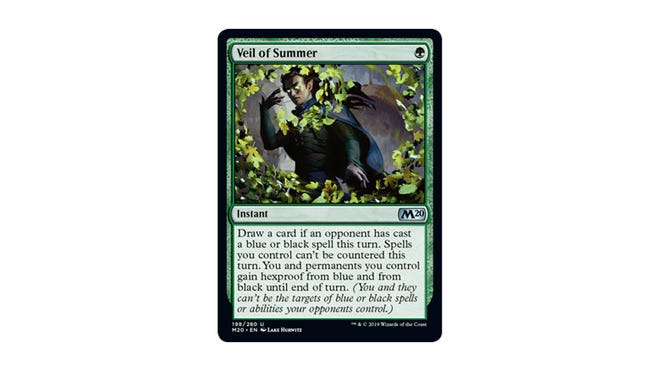10 best Magic: The Gathering cards (that you can actually get your hands on)
Decked out.
Choosing just ten of the best cards from the thousands released for Magic: The Gathering over the past near-30 years is a significant challenge. Deciding what ‘best’ even means is another challenge entirely. By the time you come to the question of actually being able to add them to your deck and use them, you’ve got more chance of finding a Black Lotus in your cereal box.
With all this in mind, we set ourselves a few limitations when choosing the top ten cards from MTG listed below. You see, if we were to simply list the most powerful cards in MTG, we’d basically just take the Power Nine and throw in another card at random. The Power Nine, for those of you not in the know, are widely regarded as the ‘best’ cards in MTG in terms of pure gameplay sway and have a price tag that corresponds with that high praise and their extreme rarity.
They’re not really worth investing in, though, because you could buy the better part of a house instead. This list should instead help inform you on the cards you actually want to - and can - get your hands on. We’ve highlighted the best cards in MTG that you could go and buy, most of which won’t break the bank either.
Best Magic: The Gathering cards
- Brainstorm (Fifth Edition): Card advantage is king.
- Deathrite Shaman (Return to Ravnica): The one-mana planeswalker.
- Lightning Bolt (Alpha): Three (damage) is the magic number
- Veil of Summer (Core Set 2020): Say no to counterspells.
- Sol Ring (Alpha): When one plus one is four.
- Demonic Tutor (Alpha): Whatever you want it to be, baby.
- Balance (Alpha): It’s not fair when you’re in control.
- Oko, Thief of Crowns (Throne of Eldraine): Your monster is an elk now.
- Jace, the Mind Sculptor (Worldwake): I’m in control here.
- Dig Through Time (Khans of Tarkir): Helping you find what you need.
These cards are all powerhouses in their own way. Each one is a great pick in nearly any situation, and just by learning a little bit more about them you’ll become a better player. Some of these warped formats - some of them still do - but all of them pack a huge amount of power onto one little bit of cardboard, and they’re all worth owning if you like playing competitive Magic: The Gathering.
1. Brainstorm (Fifth Edition)

Ah, Brainstorm. Where would we be without you there, reminding us of just how good Blue card draw can be. Brainstorm, for those not in the know, is a one-mana Blue instant that lets you draw three cards, then put two cards from your hand back onto the top of your library in any order.
There are a few things to go over here. First of all, it’s one mana, just one. That means you can play it on your first turn and it’ll help you fix your hand. Secondly, it’s an instant, which means you can cast it at the end of your opponent’s turn and then immediately draw one of the two cards back. Those are both good points, but it also literally has the words “draw three cards” on it. In MTG, knowledge is very much power - and being able to set up your next two draws and fix your hand whenever you want for such a low cost? Well, that’s value town.
2. Deathrite Shaman (Return to Ravnica)

Planeswalkers are widely regarded as one of the most powerful card types in Magic: The Gathering. That’s, in part, due to the options that each one gives to you. Flexibility in your cards is something that normally comes at a premium - whenever it doesn’t, it tends to kind of break the game.
Deathrite Shaman isn’t officially a planeswalker, but it basically is. It’s a one-mana creature, either Green or Black, that can help fix your mana, gain you life or drain your opponent of theirs. It’s an absurd card, and it’s not even that expensive to buy.
3. Lightning Bolt (Alpha)

There’s nothing complex or flashy about Lightning Bolt; it’s just good. For a single Red mana, you can deal three damage to any target. It’s an instant too, which means you can always hold it until the last second when you really need it.
This means you can kill an attacking creature, shoot a planeswalker down, take the last few points from your opponent’s life total or - this is my favourite - shoot yourself in with the Lightning Bolt to deny your opponent the satisfaction of beating you.
4. Veil of Summer (Core Set 2020)

This is one of the newer cards on this list but definitely deserves its place. Veil of Summer is a one-mana Green instant that has way too much text on it. In essence, it stops you and permanents you control being targeted by Blue and Black spells for one turn. Also, it stops spells you control being countered for that turn. Also also, it lets you draw a card if an opponent has cast a Blue or Black spell that turn.
All of that means that if you cast it in response to a counterspell, you have no longer been countered, and also you’ve drawn a card, and also there’s nothing they can do to stop you. So, presumably, you can laugh maniacally at them and their feeble attempts at interaction.
5. Sol Ring (Alpha)

The final one in our one-mana cycle on this list is, of course, Sol Ring. Sol Ring is a one-mana artifact that taps for two mana. That means that when turn two rolls around and you play a land, you have twice the mana you should have just from this one card.
As a result, it is one of the most popular cards in Commander, and exists in basically every deck in the format. In fact, if you’ve not got a Sol Ring in your Commander deck, go and fix this right now. The rest of the article can wait, but your mana acceleration can’t.
6. Demonic Tutor (Alpha)

Demonic Tutor costs two mana, one of which is Black, and allows you to search your library for a card and then put that card into your hand. In short, it lets you pay two mana to swap it for any card in your deck.
That means it’s a land if you want it to be, a creature if you’re going on the attack, a planeswalker if you want one or a game-ending spell if that’s what you need. There are very few things in life that can actually be whatever you need them to be, but Demonic Tutor manages that wonderfully.
7. Balance (Alpha)

Balance is a strange card and is another one with a lot of text. It’s a two-mana sorcery, one of which is White, and is used as part of a lot of strategies that are somewhere between hilarious and so frustrating that you’ll never want to play MTG again.
In essence, it balances the lands, creatures, and cards in hand in line with whoever has the lowest amount of each. You can exploit this by playing cards like artifacts, or by sacrificing your cards or discarding them as it resolves. This effectively destroys every resource your opponents have, and will lead to some very one-sided victories.
8. Oko, Thief of Crowns (Throne of Eldraine)

Oko is hot. That’s nothing to do with the card; I’m just stating facts. He’s also a three-mana planeswalker, one of which must be Blue, and one of which must be Green. He’s also one of the healthiest low-cost planeswalkers around as he comes in at four loyalty - essentially a planeswalker’s health - and then can immediately go up to six loyalty.
Of course, his abilities are what make him so intensely powerful. His first ability allows him to create a Food token, which can be sacrificed for health. His second ability turns any artifact or creature into a 3/3 with no abilities. That’s the really powerful one, because it effectively removes any threat you can’t deal with. His final ability allows him to swap an artifact (like a Food token) or a creature you control with a creature an opponent controls that has three or less power. Good readers, he kind of does it all.
9. Jace, the Mind Sculptor (Worldwake)

The only other Planeswalker on our list is, of course, Jace, the Mind Sculptor. He’s the poster boy of MTG for a reason - and it’s definitely not his personality. He costs four mana, two of which is blue, and lands at three loyalty.
His top ability lets you control either your or your opponent’s draws by changing the top card of the library. He can Brainstorm. His third ability removes a creature from the board, and his final ability exiles an entire library - removing it from the game - before turning the player’s hand into their library. This, more often than not, wins the game on the spot.
10. Dig Through Time (Khans of Tarkir)

The final entry is Dig Through Time. This card is absurd. It is an eight-mana card, two of which is Blue. That seems like a lot, but you can exile cards from your graveyard to pay for six of it, which means it’s usually a two-mana instant instead.
It lets you look at the top seven cards of your library and choose two to put in your hand. That’s usually the better part of a quarter of your library, meaning you can always find at least one card that you really want at the time. It’s absurd, it was banned in nearly every format and it deserves respect.










